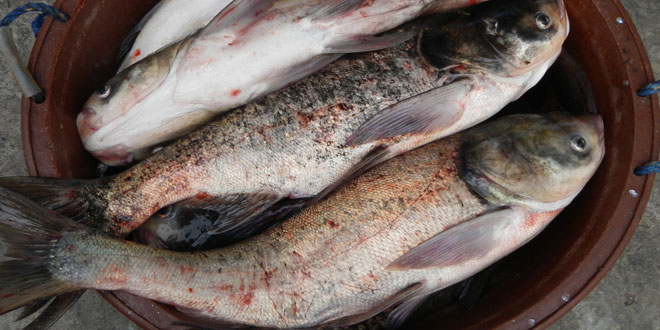TORONTO—Members of the public need to be allowed to ask questions and hear the potentially huge effects Asian carp could have on the Great Lakes, including waters like Lake Huron.
“I was disappointed that there was no time for questions to be posed,” said Mary Muter, chair of the Great Lakes Section of the Sierra Club of Canada and vice-chair of Restore Our Water International (ROWI), after a presentation by US and Canadian representatives concerning the threat of Asian carp in the Great Lakes at the Ontario Federation of Anglers and Hunters (OFAH) annual general meeting held this past weekend.
“Canada, and particularly Ontario, already know about Asian carp and about the effects they are having and could have in the Great Lakes,” said Ms. Muter. She pointed out the speakers at the meeting, included John Goss (the carp czar in the US) with the Environmental Protection Agency council, who had been appointed by President Obama and the US government to coordinate the US efforts in dealing with Asian carp, Eric Boysen of the Ontario Ministry of Natural Resources (MNR) and Dave Burden of Fisheries and Oceans Canada.
After hearing the information provided at the OFAH meeting, Ms. Muter is even more concerned in regards to the Great Lakes and Mississippi River Interbasin Study (GLMRIS) Canadian Information session being held next week in Toronto.
“I don’t understand why the meeting in Toronto is closed to the public, it is by invitation only. People need to know what is going on and steps being taken to mitigate the problem,” said Ms. Muter. She said the meeting has been opened up to webinar and pointed out the information session is being headed up by the MNR Invading Species centre, DFO and USACE board of GLMRIS Study representatives will be in attendance.
“The GLMRIS study presented a series of options to be considered to curtail Asian carp in the Great Lakes in the $20 million report released in January,” said Ms. Muter. “This is the first and only Canadian information session being held; they must have had about a dozen such sessions in the US presenting the findings of the GLMRIS study,” said Ms. Muter.
“Most of the GLMRIS report options ran to a cost of $17-$20 billion, with half of that to upgrade the Chicago water system,” said Ms. Muter. Dr. Terry Quinney of the Ontario Federation of Anglers and Hunters (OFAH) said at the meeting last week there is a $8.3 billion fishery in the Great Lakes that will, and is, being affected by Asian carp, she pointed out. “Once the carp get into an area they decimate all fish species.” “They still have status quo as one of the eight options being considered in the GLMRIS study,” stated Ms. Muter. “Hopefully there will be time at the information session to ask why status quo is still number one on the list as an option. We know that it has been shown that four-inch long fish have been found swimming through the barriers in place already that are supposed to keep Asian carp and other invasive species out of the lakes. Obviously something needs to be done, at least take temporary measures for now to block Asian carp from getting any further. “And if, as they are saying, any of the options for barriers will take 25 years to put in place, forget it, we don’t have the time to wait for them,” said Ms. Muter. “We heard reports at the (OFAH) meeting that Asian carp (DNA) has now been found 250 miles north of what has been previously been found. The fish are moving far faster than all the experts have indicated. We know commercial fisherman are harvesting carp and this is great, but even with this, Asian carp have been found closer to Lake Michigan than had previously been thought. This is unacceptable.”
“It is unacceptable that they are not talking about at least temporary measures to keep carp out of Lake Huron and the Great Lakes,” said Ms. Muter. “After getting into the Great Lakes within two years it is expected they will invade Lake Huron and one of the areas I think they would head to is the wetlands of Manitoulin Island,” she continued. “And we have now been told Asian carp only need a population of 10 for reproduction of their population, when each female lays two million eggs per year. The public needs to know the serious problem they are going to be on the Great Lakes and Lake Huron.”
The GLMRIS study was released by the US Army Corps of Engineers on January 6 to present decision makers with a range of options and technologies to prevent the transfer of aquatic nuisance species (ANS), between the Great Lakes and Mississippi River basins through aquatic pathways.
The Great Lakes basin is an ecosystem of great importance for Canada and ANS invasions have severely impacted the economic and environmental resources of this ecosystem in recent years. ANS can threaten native plants and animals; reduce abundance and variety of native species; harm important terrestrial and aquatic ecosystems; degrade water quality; transport diseases and result in economic, political and social impacts. Because ANS populations span watershed and government jurisdictional boundaries, efforts to manage them must be coordinated across these boundaries.
The GLMRIS Canadian information session agenda will include a presentation by the United States Army Corps of Engineers on the GLMRIS report, discussion of the GLMRIS report from the Canadian perspective and update on work being done in Canada and the United States on Asian carp.





